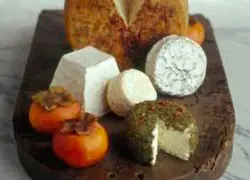Goat cheese itself was first made in the Asian country, but starting in the 13th century, it became known in Europe. The conquest of the European continent began with the Roman Empire, where the recipe brought by the Moors reached. The Romans appreciated the goat analogue of the original cow product, and then its widespread distribution followed.
Generally speaking, in ancient times goat cheese was not considered a delicacy, it was a common everyday food, eaten all day long in any quantity.
And in our time, this food has become an expensive and refined pleasure. France is the leader in the production of various types of goat cheese, and it also has the majority of protected production certificates.
The beneficial properties and vitamin content in this cheese are tens of times greater than in its analogues made from cow's milk. Because this milk has a higher fat content and amount of protein. It is known that a goat is a very capricious animal; it does not consume silage or feed, but eats fresh fortified grass, loves vegetables, fruits, and so on. And the richer the nutrition, the more vitamins there are in the milk, and, consequently, the product made from this milk is more useful for people, and especially for children.
The process of making goat cheese is not very different from the traditional recipes we have already discussed. Raw milk is heated slightly, then the curdling process begins. After straining and removing the whey, the resulting mass is placed in molds, salted and left in the cellars to mature. This is why the edges of the product wrinkle over time and the edges turn blue from mold. Depending on the length of ripening time, the taste of the product also varies. Young is softer and more delicate with fruity undertones, and mature is sharp and piquant with a nutty aroma.
The following are the most famous types of goat cheese:
- Saint Maur - has the shape of a roll with a snow-white cheese mass covered with a black crust. Produced in France.
- Crottin de Chavignolles - comes in the form of small circles with a gray coating. It is produced similarly in France.
- Chevre is a hard French specimen with a white mass, quite pungent in taste.
- Chabichoux du Poitou is soft with a creamy mass and a crust covered with white mold. Produced in France, Poitou region.



